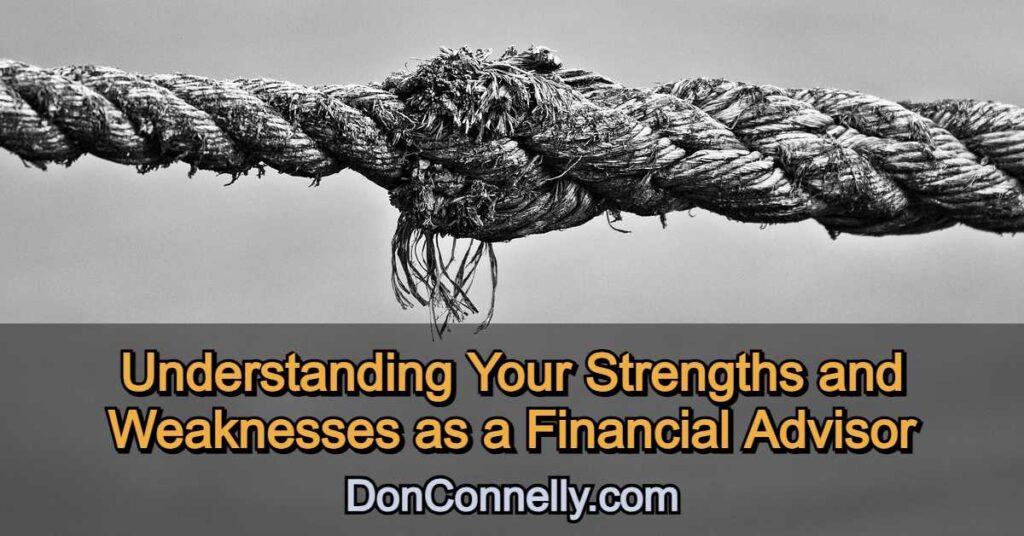Understanding Your Strengths and Weaknesses as a Financial Advisor
 For financial advisors with ambitions of taking their practice to the next level, self-awareness is fundamental to their success. Knowing your unique strengths enables you to maximize the value you deliver to clients while understanding your weaknesses helps you address critical areas that may impact your effectiveness.
For financial advisors with ambitions of taking their practice to the next level, self-awareness is fundamental to their success. Knowing your unique strengths enables you to maximize the value you deliver to clients while understanding your weaknesses helps you address critical areas that may impact your effectiveness.
Continuous self-assessment to develop a clear picture of your strengths and weaknesses is essential in a fast-evolving industry where personalized service and superior client experience have become minimum expectations.
Why it’s critical to understand your strengths and weaknesses
Your strengths and weaknesses, whatever they may be, directly influence your performance. Leveraging your strengths can make you indispensable to clients. For example, a skilled communicator can build trust, translate complex information clearly, and engage clients more effectively. Analytical skills can help dissect intricate financial data, allowing you to provide tailored recommendations that align with your clients’ long-term goals.
However, unchecked weaknesses can undermine client trust and impede growth. For instance, a lack of organization could lead to missed follow-ups or oversight of critical details, potentially affecting your reputation. In an industry where trust and reputation are everything, it’s vital to continuously reassess your strengths and weaknesses to ensure you can always meet your clients’ expectations.
Methods for identifying personal strengths
Self-assessment is not just an introspective exercise; it requires gathering insight from multiple sources, including:
#1. Self-reflection
Reflect on your career thus far. Ask yourself questions like, “What aspects of my work bring me the most satisfaction?” Or “What tasks do I excel at consistently?” Self-reflection enables you to identify strengths that feel natural and enjoyable, which are usually the ones you utilize most effectively.
#2. Client feedback
Clients can provide invaluable insight. Consider using surveys or holding informal feedback sessions to understand what they appreciate most about your approach. Client feedback can illuminate strengths you may have yet to recognize, such as your empathetic listening or ability to simplify financial jargon.
#3. Peer and manager feedback
Colleagues and managers witness your strengths in a professional context and can offer perspectives you might miss. A manager might highlight your reliability in managing complex portfolios, or a peer could praise your collaborative skills in team projects. This feedback helps you understand where you excel within a team setting, which can be valuable in collaborative roles.
#4. Assessments and tools
Various assessments can reveal strengths that align with your natural inclinations. Tools like StrengthsFinder, Myers-Briggs, and Disc are designed to evaluate strengths and work preferences. For example, StrengthsFinder might reveal that you have a “Strategic” or “Relator” strength, which can be applied to client interactions and portfolio management strategies.
Identifying and addressing weaknesses
You may find it more challenging to identify weaknesses because it often involves confronting discomfort or vulnerability. However, the sooner you can identify and address these areas, the more effective you become at meeting your clients’ expectations. Here are some ways to identify and address your weaknesses.
#1. Self-reflection on challenges
Think back to times when you struggled or felt uncertain. What aspects of those situations were most challenging? Maybe you found it difficult to move clients to action or felt overwhelmed by time management demands. Recognizing these challenges is a first step toward addressing underlying weaknesses.
#2. Client and peer feedback
Constructive criticism from clients and colleagues can reveal blind spots. For example, a client might express confusion over explanations, suggesting you could benefit from honing communication skills. Colleagues, too, can offer insights that help you refine interpersonal dynamics and identify areas for improvement.
#3. Continued education and skills development
Addressing weaknesses often means actively working to develop skills. This could involve enrolling in a public speaking workshop, attending financial planning webinars, or taking online courses on soft skills or technical skills like financial modeling or data analysis.
#4. Mentorship and coaching
A mentor or coach can provide ongoing support, giving you tailored advice on overcoming weaknesses. They can offer insights from their experiences, suggest resources, and provide practical guidance on implementing change. Regular check-ins with a mentor can keep you accountable and ensure you’re actively working on your development.
Creating a personal development plan
Once you’ve identified your strengths and weaknesses, creating a roadmap for improvement is essential. Setting actionable goals allows you to target areas that will yield the most growth. For example, if you’ve discovered that communication is a strong suit, you might consider hosting client workshops or educational seminars. Conversely, if time management is a weakness, adopting a robust CRM system could help streamline client interactions and follow-ups.
Prioritize your goals based on immediate needs and track your progress regularly. Revisit and revise these goals as you grow, ensuring they remain aligned with your evolving professional landscape.
Maintaining a growth mindset
A growth mindset is essential for making the most of your self-awareness. Recognizing weaknesses not as limitations but as growth opportunities empowers you to transform challenges into development areas. Resilience and adaptability will serve you well in a landscape where new financial products, technology, and client expectations are constantly evolving.
Celebrate small victories along the way—acknowledging progress keeps you motivated and reinforces your commitment to growth. A mindset of continuous improvement can create a foundation for long-term success, enabling you to adapt to change and better meet client needs.
Bottom Line
Understanding and acting on your strengths and weaknesses is a powerful way to enhance your skills as a financial advisor. By investing time in self-assessment, you position yourself for greater success in client relationships, career satisfaction, and professional development.
Start your self-assessment journey today. Consider trying a strengths-based assessment tool or seeking feedback from a mentor or peer. Committing to lifelong learning and growth will enable you to navigate the industry’s challenges and capitalize on opportunities, ultimately driving both personal and client success.
Watch this 3-minute video to learn how our 24-step training program will help you become brilliant at the basics and take your business to the next level.
See program details and enroll today!
Available as a self-paced program (always open) or as a 12-week coaching program (open only a couple of times a year), this training will change the way you view your practice and will give you an enormous advantage over your competition. Select your format and enroll now!



